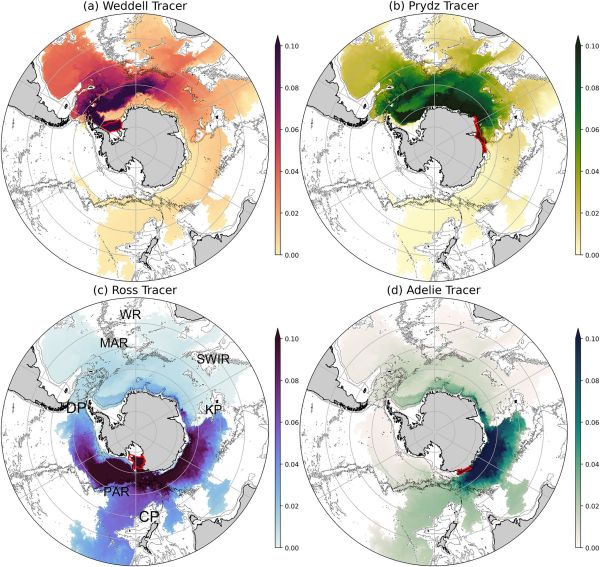As the surface ocean warms and polar ice sheets melt due to increasing anthropogenic greenhouse gases in the atmosphere, near-surface stratification is increasing almost everywhere, including the major deep water formation regions in the high-latitude North Atlantic and around Antarctica. As a result, the global Meridional Overturning Circulation (MOC), also known as the global ocean... Continue Reading →
Antarctic Bottom Water (AABW) export pathways across the Southern Ocean
The Antarctic Bottom Water (AABW) is the densest water mass of the global ocean that covers about 30 ~ 40% of the global ocean volume with temperatures ranging from -0.8 to 2°C and salinities from 34.6 to 34.7 psu. It forms around Antarctica and spreads into the Southern Ocean and then into the Atlantic, Indian,... Continue Reading →
New aircraft-based observations confirm the role of the Southern Ocean as a significant carbon sink
Ship-based CO2 flux estimates of the contemporary air-sea flux of CO2 showed that the Southern Ocean (south of 35oS) plays an important role as a significant carbon sink, with a net uptake at the rate of −0.8 ~ −1.0 Pg C/year (Takahashi et al., 2009; Landschützer et al., 2014) largely consistent with climate model-based estimates... Continue Reading →
Increasing river alkalinity slows ocean acidification in river-dominated ocean margins
Although ocean acidification (OA) is mainly driven by the ocean uptake of anthropogenic carbon dioxide from the atmosphere, multiple factors including changes in ocean temperature, biological processes, and river discharge influence its temporal progression. In a new paper accepted in the Geophysical Research Letters, a team of researchers from the Northern Gulf Institute of the... Continue Reading →
Arctic Ocean is experiencing dramatic weight loss due to increasing freshwater storage
The freshwater cycle in the Earth System is a delicate balance between the net loss (i.e., evaporation > precipitation) in the warm tropical-subtropical oceans, the net gain (i.e., precipitation > evaporation) in the cold polar oceans, and the net poleward transport by the atmosphere. These processes maintain the tropical-subtropical oceans salty and the polar oceans... Continue Reading →
Increasing poleward intrusion of the Circumpolar Deep Water and its impact on the changing ocean-biogeochemistry of the Southern Ocean
A study published in Nature Geoscience (Bronselaer et al., 2020) analyzed new observations from autonomous floats with ocean-biogeochemical sensors (Bio-Argo) along with historical shipboard ocean measurements to document changes in Southern Ocean physical and ocean-biogeochemical variables (i.e., temperature, salinity, pH, concentrations of nitrate, dissolved inorganic carbon and oxygen) during the last two decades. Due to... Continue Reading →
New multivariate metrics help better monitor and predict global coral breaching events
Key factors that affect regional coral bleaching have been well studied and documented. These include extreme warm temperatures, the duration of extreme cold temperatures, and temperature bimodality (i.e., the exposure of corals to two distinct temperature regimes). However, some of these factors are more important than others in different regions because there are complex and interactive responses to... Continue Reading →
Enhanced carbon sequestration by the North Atlantic Ocean during the Last Glacial Maximum
According to Redfield stoichiometry, marine organisms incorporate and release PO4 and Dissolved Inorganic Carbon (DIC) in a relatively fixed proportion. Additionally, PO4 in the ocean is not affected by air-sea exchange. Therefore, PO4 and DIC in the ocean can be used to estimate biology-driven versus air-sea flux-driven oceanic DIC redistributions. Applying this method to sediment core data, a new paper... Continue Reading →
Deep Indo-Pacific Oceans are still in the Little Ice Age
The Little Ice Age (LIA) is a period of cold global average surface temperatures from around 1600 to 1850, following the Medieval Warm Period (950 ~ 1250). A new study published in Science suggested that since the ocean adjusts to the surface thermal anomalies with the time scales of 100 ~ 1,000 years, some parts of the... Continue Reading →
Glacial weakening of the AMOC and the associated increase in deep ocean carbon deposit
During the mid-Pleistocene between 1,250 and 700 kyr ago (ka), Earth’s climate oscillated between warmer interglacial periods and cooler glacial periods with reduced and expanded polar ice sheets, respectively. Paleo records indicate that the Atlantic meridional overturning circulation (AMOC) was relatively weaker during glacial periods likely due to reduced evaporation and increased freshwater input from glaciers to the... Continue Reading →










